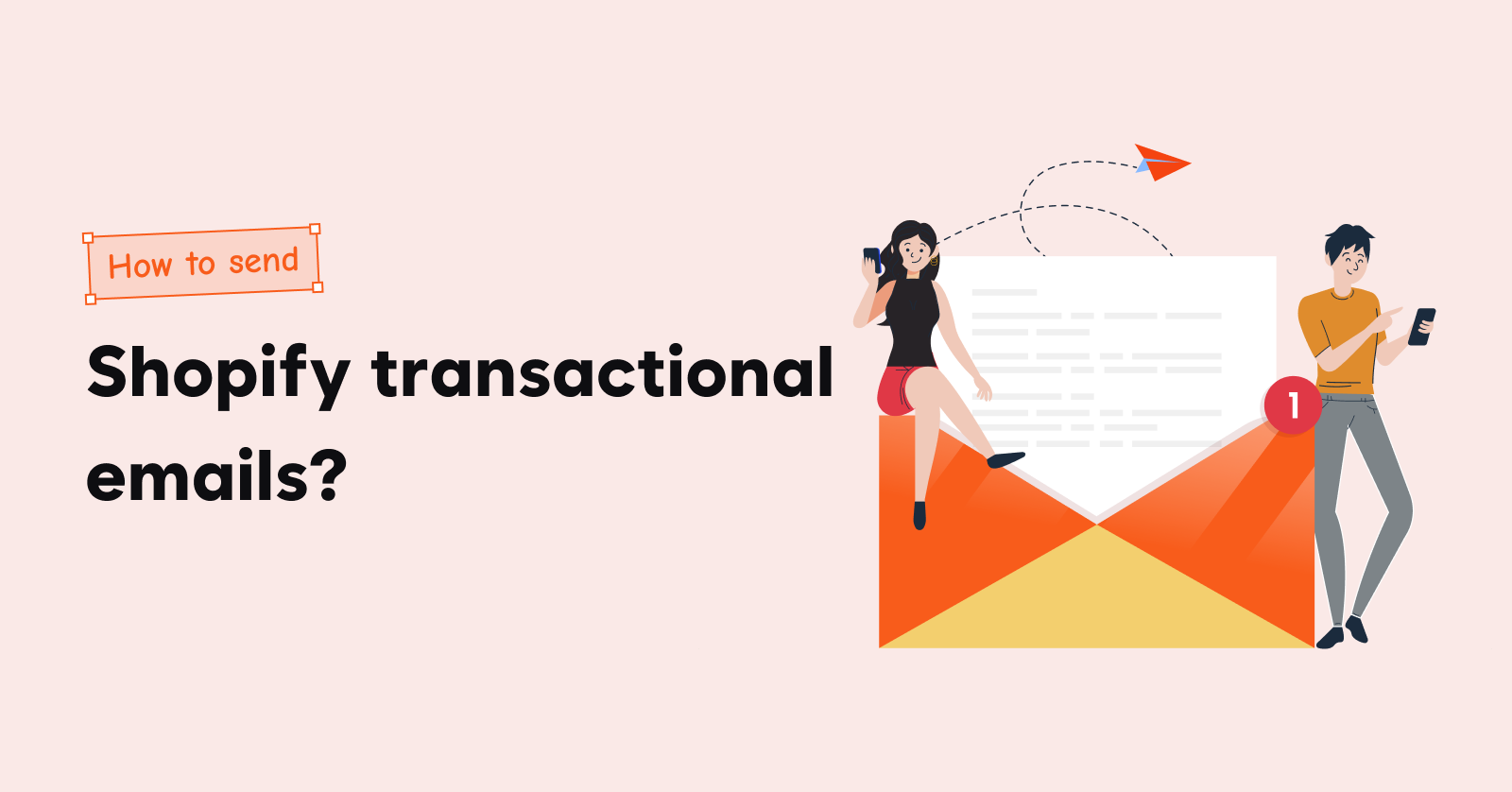Efforts need to be put in to better your eCommerce website at any cost because there are quite a number of them cropping up every other day. The rat race is insane.
Data-driven and thoughtful EFFORTS.
Efforts to increase eCommerce traffic.
Efforts to convert website visitors into customers.
Efforts to claim the top spot and remain there.
This informative read focuses on the first step – how to drive more traffic to your store? Indulge, learn effortlessly and take back home a new tactic for traffic building and eCommerce website optimization.
Boost Customer Retention by guiding them using timely, automated, and personalized emails with Retainful.
Why online businesses should concentrate on eCommerce traffic generation?
Why on earth would you ask that question?
Of course, you need website traffic to generate more leads and sales. As simple as that.
It’s high time you rethink the importance you have given to driving traffic to your online store all this while. If you have not bothered much about it yet, take a look at this marketing and sales funnel.
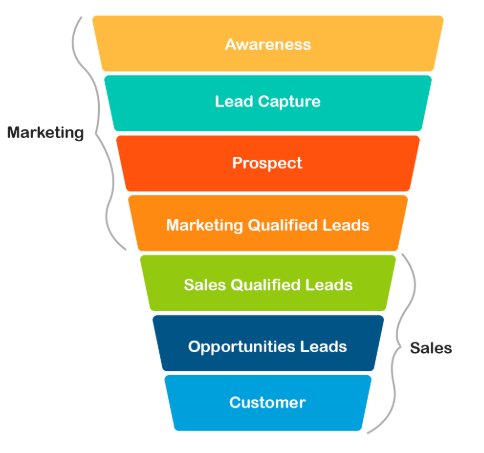
The eCommerce funnel is wider at the top with more number of people coming in initially. At each stage of the funnel, an unimaginable number of prospects drop out, leaving just about 1 – 5% at the end as customers.
If the inflow of prospects takes a hard hit, the conversion rate too declines if certain precautions are not taken. So, focus on how to get more customers in your store as long as you plan to run your WooCommerce or Shopify store.
How leading eCommerce companies increase online store traffic?
The strategies that can be used to bring in visitors to websites in eCommerce are plenty. Let’s not get into the numbers now.
Irrespective of the number of ways in which traffic building and eCommerce optimization is possible, there is one common factor that brings all of the strategies under one roof – Customers.
All your trials to increase eCommerce traffic sources must be focussed on the well-being of the customer. When he/she is satisfied, there is no reason for your traffic/sales to drop. In short, make your strategies customer-centric and this is what leading eCommerce do to increase online store traffic.
9 Proven ways to drive more traffic to your store
Meditate on traffic because you need tons of it to reap success in eCommerce. 9 proven sure-shot strategies are discussed here. Read on.
eCommerce Facebook ads
Facebook is the torch-bearer for social media promotion. If ‘how to market your eCommerce website?’ is your concern, consider Facebook first. There are many types of Facebook ads that can be leveraged to increase online store traffic. Video, image, lead, carousel, slideshow, etc.
Either stick to one type of ad or use 2 to 3 types in rotation to attract consumers. Video ads, lead ads, and retargeting ads are highly recommended.
Video Ads
Video ads click because
- The interaction rate for a Facebook video is much higher than that of a Youtube video. Facebook videos are so valuable.
- The impression that visual content creates stay longer in memory and has a positive effect on sales for eCommerce.
Video ads must be all about just one product when it is for the eCommerce sector. Say, you want to promote a new couverture chocolate brand. It is suggested to present a baking or cooking video using that chocolate. Rather than just presenting images of the chocolate, videos sell better.
Lead Ads
More leads increase online store traffic but lead ads are meant to be used only for mobile devices. Absolutely no issues. It so happens that more people browse and shop using mobiles.
Here is an example.
Philosophy is a beauty brand that used lead ads to generate 9000 leads within a span of 15 days. Impressive.

Points to note
- Lead ads alone cannot be used for eCommerce traffic generation because you only get to collect email addresses. Follow-up with email marketing to get them to your website.
- In the example mentioned above, Philosophy used link ads along with lead ads for their campaign. Link ads take the Facebook user directly to the desired webpage.
- Choose your audience to target them better.
Retargeting Ads
Facebook ads are incomplete without the mention of retargeting. Some even call it remarketing.
This is all about getting in touch with the existent, inactive user base. It also serves as a reminder for abandoned carts. What do you retarget your customers with?
Retarget with
- A product
- Blog post
- Service offering
- eBook page
- Anything that provides some value
Facebook Offers
The time it takes to set up offers on your Facebook page is just minutes but the returns are literally multi-fold for the time spent. This is one simple way to spike the eCommerce website traffic.
Here is an example of Facebook offers

Rosetta Stone gives an offer of 35% for traffic building and eCommerce sales. The button ‘Shop Now’ takes the person to the Rosetta website directly. This is initially set up as a normal Facebook post that can be liked, shared, and commented on to get a wider reach.
A step further, this post can be turned into an ad to increase views. Facebook offers setup page has this option called ‘Boost post’ to do it.
What other features does the Facebook offers setup have?
- Limit the number of people who can claim the offer.
- Three options to redeem offers – online, in-store, and both.
- Set an expiration date for the offer.
Google Ads for eCommerce
Let’s discuss two types of Google ads for eCommerce – shopping ads and search ads.
Google Shopping Ads
Creating shopping ads is easy. You just have to create a Merchant account with Google and upload your product feed/information.
Based on the feed, Google will decide if your product needs to be displayed there.
Pro tip – See that you are persistent in gathering customer reviews. Star-ratings are displayed in the shopping ads which has a direct impact on the CTR.
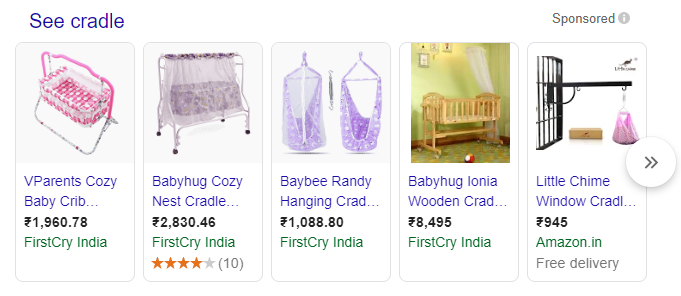
Type in the word cradle, and this is what comes up. All eyes are on the second product with the star-ratings. It is only obvious that this particular product will a higher CTR.
eCommerce PPC – Search Ads
The key to getting featured in a Google search ad is using the right keywords. Google Keyword Planner Tool can be leveraged to choose the ones that promise higher conversions.

In the image shown above, the search results are for the term ‘laptops’. Most people will go for the first and second ad. You know why? It is because of the use of ad extensions. Ad extensions provide the benefit of fitting in more information and links to the website relevant to the search.
Tip for better Google Search ads – The copy written for search ads must be optimized for keywords. Keywords used by competitors can be utilized to your advantage. Make sure to mention it in the headline itself.
SEO for eCommerce
Search Engine Optimization. This is a must-do if you are thinking about how to get more customers in your store and rank better in Google.
Google takes into account over 200 factors to rank web pages. Let’s have a look at the most important ones.
The concept of ‘keywords’ comes running to your mind with the mention of SEO. Yes, let’s discuss keywords optimization along with 3 other SEO factors.
Keywords Optimization
No keywords. No SEO. They both go hand-in-hand and the types of keywords are plenty in number.
Irrespective of the number, as a WooCommerce store owner, you must be familiar with the following 3 types of keywords.
Short-tail keywords
Keywords that have a word count of 3 and less are considered short-tail keywords. For example, in this post, ‘increase eCommerce traffic’ is a short-tail keyword.
Short-tail keywords are
- Vague
- Not specific
- Their presence is absolutely important as a starting point for SEO.
Long-tail keywords
Neil Patel calls long-tail keywords the holy grail of SEO with reason. 70% of web searches consist of long-tail keywords. He emphasizes concentrating on these keywords that will help generate content that is sought after by the customer.
Long-tail keywords are ones that are
- Specific in nature
- Low search volume
- High conversion rate
Hence, the chances of ranking higher with Long-tail keywords are better.
For example, ‘buy Swiss watches’ is a short-tail keyword with high search volume. The number of websites that compete for this term are also higher.
Instead, use long-tail keyword like ‘buy handmade Swiss watches online’, the search narrows further down and you may attract more eCommerce website traffic.
LSI keywords
LSI – Latent Semantic Indexing. Keywords that have a semantic relation to the main keyword are called LSI keywords.
Google the word ‘dressing table’ and you will find related searches at the bottom of the page. They are the LSI keywords. This is very helpful to write content on a broad theme with information of all the relevant searches.

Product Page Optimization
Here again, the work on an SEO-optimized product page starts with the right set of keywords. Keywords with high search volume are to be used in 4 places on the product page
- URL
- Tags – Title, H1, H2, and H3
- Product description
- Meta description
To make it easier for the search engine to spot the keywords, it is advised to keep the writing simple yet effective.
Other factors that add to SEO ranking for product pages are
Product Reviews
Search engines love updated and fresh content and updated reviews are one of them. Make sure that your customers review the product purchased.
Product Images
A product page without images will not perform well. Name the images using keywords so that the search engines locate them without much difficulty.
Product Videos
Videos are a great idea for how to drive more traffic to your store. It not only educates the customer about the products but also boosts the possibility of sales.
Backlink Profile
Neil Patel says, “The No.1 factor that affects rankings is backlinks.” One of the prime strategies that fall under off-site SEO – creating backlinks to increase eCommerce traffic.
Backlinks are incoming hyperlinks from one web page to another.
Factors that determine backlinks
- Quality
Backlinks from sites with proven domain rating according to a website authority checker must be given preference. In other words, sites that are very much popular and ones that already have a good reputation with Google search rankings.
- Quantity
Websites that are years old are bound to have a huge number of backlinks in thousands. For beginners, it is essential to start off with at least 25 to 50 backlinks with 70% no-follow and 30% follow.
Prefer quality over quantity, no matter how old your eCommerce business is.
How to start generating backlinks?
- Copy your competitors’ strategy and according to a link building report.
- Track down broken links and optimize them
- Start guest blogging
- Reach out via email to get backlinks
- Ask competitors’ to give you a mention
Google Search Algorithm updates
The search algorithm is the one that determines the factors to stay on top of the search results. There has been a recent and very important algorithm update that affects rankings.
BERT update
BERT – stands for Bidirectional Encoder Representations from Transformers.
Google rolled out the biggest ever search algorithm update after Rankbrain. Natural Language Processing is the focus of this update by using Artificial Intelligence and it impacts 1 out of 10 searches, especially the featured snippets.
The search engine giant now understands the relation between words, i.e, the meaning of articles, prepositions, and conjunctions. Earlier on, SEO strategy was all about focussing on keywords. Now, other relative words must be taken into account too while planning the content.
eCommerce email marketing
Email marketing is similar to advertisements. A person comes across hundreds of emails every day only to open up a few of them. Want to get noticed? Get set to create exceptional emails that leave a mark. A positive mark.
Emails are prompted to invite the customer to the website and it starts right after the address gets collected in your database. Email maps the customer’s journey.
Sending out emails start with email collection. Post email list building is all about setting the right email templates and measuring the performance.
Subject lines hack
Subject lines must intrigue the reader to open up the email. How do you do that?
Here are some hacks to follow.
- Keep the subject lines short.
Gone are the days of long subject lines. If you want your email opened, stick to the common subject line length of 7 words. 3 words would do even better because they have the highest engagement rate of 21.2%.
- Use words like ‘now’, ‘daily’ and ‘weekly’ for higher engagement rates.
- Avoid the words ‘free’, ‘monthly’, ‘now’, ‘subscription’, and ‘early bird’.
- Numbers can do magic. Mention the discount offered or the countdown to make the purchase happen.
- Get transparent and be upfront about the email contents. Refrain from being too creative unless you know your audience well.
- Use the customer name and personalize the email.
Actionable email copies
The title says it all. The email copy must trigger the reader to take action immediately.
Action can be any of the following
- Subscribing to become a member
- Buying a product
- Writing a review/testimonial
- Referring someone
- Spreading the word on social media
- Downloading exclusive content
- Signing up for a contest
What components of the email content urges the reader to act without delay?
The characteristics of an email that drive visitors to website in eCommerce are
Email header
The opening lines of an email must be interesting enough to keep the reader hooked. For example, consider an abandoned cart email. The header can be something like “Are you fine if someone else takes away your favorites?”. There must be a reason to continue the read.
Personalized, customer-centric content
It is about how a particular action to be taken by the customer benefits him. In other words, the content must not boast about your eCommerce company, rather it must convince the customer with the right reason to make the email actionable.
High-quality images
Bad images leaves a negative mark for lack of quality. This must be done and definitely not optional.
Clearly visible, prominent CTA
CTA is very important for a successful email copy. 3 things must be considered here.
- Color – This must be of real contrast compared to the rest of the email template to male it noticeable.
- CTA copy – Use words like ‘Act now’, ‘Buy now’, ‘Grab it’, and ‘Take a look’.
- Make sure that the CTA links to the correct page as desired.
Enticing discounts/rewards
The offer given to the customer must satisfy him. This is all it takes for the email to be successful.
Here is a sample flowchart for an email series.

Of course, there are many other email types like promotional, seasonal, upsell/cross-sell, discount, feedback, reminder emails that can be included in this structure and customized as per your needs.
Measure and track insights
It does not stop with sending the emails. You will have to track the performance and record the results. The main parameters to be considered are
- Open rate – the percentage of people who open up the email
- Click-through rate – the percentage of people who respond to the email by clicking on the CTA
- Conversion rate – the percentage of people who convert or successfully complete the action
Other parameters include the time and day when the email is sent, segmented/blast approach, and more.
Hold on to the emails that make a break-through and modify the others that need to perform better. Keep experimenting and testing.
Retain customers effortlessly. Make your customers feel valued and appreciated with Retainful.
Improve eCommerce Site Performance
Site performance must also be taken into account if you are wondering how to drive more traffic to your store. A well-built eCommerce website that is managed accurately and updated as per the customer expectation wins.
Shop UI/UX
User Interface/User Experience is nothing but the ease at which an eCommerce websites can be used. Here are some of the points to be considered to make people stay for longer on your website.
- Clear-cut, responsive layout design that benefits mobile users too.
- Instantly visible CTA on landing pages and product pages.
- Availability of contact, product, and other information sought after by the site visitor.
- Page readability with highlighted keywords and shorter paragraphs.
- Smooth and short checkout flow with autocomplete forms.
eCommerce speed optimization
Site speed is one vital factor to increase eCommerce traffic generation. Optimizing site speed is a solution to the question ‘how to improve eCommerce website performance?’
A compilation by Kissmetrics says
- 47% of website visitors expect a page to load in 2 seconds or even lesser
- 40% of visitors leave the website if the loading time goes beyond 3 seconds
Did you know that Amazon will lose $1.6B/ year if the speed of the site slows down by just 1 second? This is why they do not take chances. Here are the results for you to see.
Result 1

Amazon.com increases eCommerce website traffic with a Speed Index of 1.002s when viewed from Dallas using Chrome.
Result 2
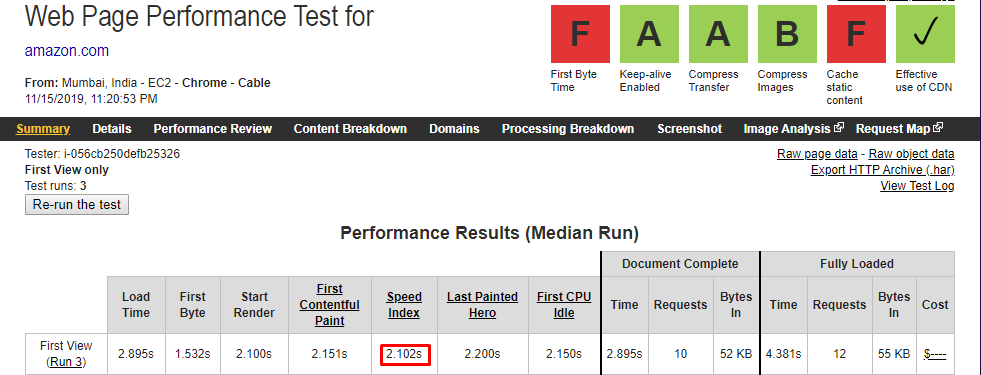
Amazon.com has a Speed Index of 2.102s when viewed in India using Chrome browser.
The same website shows different timings when the location changes. This is what you learn here.
Takeaway
Website speed differs based on the geography. But why?
Competitors are taken into consideration when setting up the site. You just have to stay on top. 2.102s must be the best speed in India but definitely not for the USA where the competition is much tougher in the online retail sector.
By the way, Retainful has Speed Index of 2.930s (Yah! Below 3).
Other parameters based on which speed differs are device and industry. Yes, the average mobile page speed for the retail sector in the US is 9.8s. So, take into consideration all of these aspects and decide on how to make your WooCommerce store load quick.
Navigation Check
Smooth navigation is one key factor for driving traffic to your online store. 35% of users leave a website due to poor navigation. If website visitors find it hard to spot a product, they are never going to return.
If your eCommerce website is search-friendly, then your navigation is for sure top notch.
How do you do it?
- Present product listings that start with a general categories, further moving on to specific products.
- Place the listings either on the top or on the left side of the screen.
- Provide filters based on category, price range, color, size, to help narrow down the search.
- Use images to help narrow down the search.
- Place a visible search bar, preferably at the top of the page.
Take a look at this example from Melorra.

The eCommerce website that sells jewelry has categorized the product on all possible levels using images, new arrivals, offers, by price, and other criteria. This makes it easier for a person to navigate the website.
Referral Marketing and Affiliates
The news of your eCommerce website must reach tens of thousands of ears to increase the traffic. There is nothing better than encouraging referrals in return for some rewards and affiliate marketing. Look at them in detail.
Refer and Win
Without a doubt, a referral marketing strategy is one extraordinary trick to increase eCommerce website traffic. Referrals are the digital version of word-of-mouth marketing.
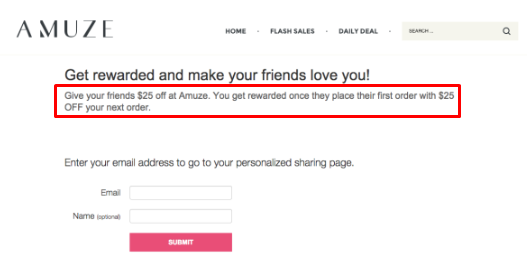
Amuze is a designer label that deals with high-end fashion. The above image is that of their referral program that gives $25 off for the existing customer and the person referred. People will definitely take the reins looking at the reward. This strategy has two-way benefits. No wonder why people will swarm the website.
Points and Rewards
People can never have enough of points and rewards if they are useful.
What can be the types of rewards?
Rewards can be of any type like
- Money
- Loyalty points
- A complimentary product
- Early access for flash sales / new product launch
Of all, money as a reward is the best way to market online stores and 77% of Americans vouch for it.
Sephora’s Beauty Insider is the best example for points collection.
Members who purchase products collect points along with it. With the accumulation of these points, they can claim beauty products as rewards twice a week.

In addition to the product rewards, Sephora also gives away monetary benefits and samples. To avail these benefits, becoming a member is mandatory which will increase eCommerce website traffic.
Affiliate Marketing in eCommerce
Of all the online orders, 16% of them have generated affiliate marketing. The growth of the US affiliate market is expected to hit $6.8 billion by 2022. What more information do you need to get started with affiliate marketing?
Affiliate marketing is the use of marketers as middlemen who utilize various methods to sell your product. In return, when a sale happens, a small percentage of the money goes to them.
As an eCommerce website owner, say, you only have 3 to 4 ways to market your products. When the same job is given to 10 others with specific focus on a particular product, 40 other ways to market are paved. Affiliate marketing is one answer to ‘how to drive customers to your store?.

The success of Amazon is hugely because of the affiliates program introduced by them. Lucies List is an Amazon affiliate that specializes in baby product reviews. The website has around 213.80K visits in a month.
Count on Content Creation
Content rules the eCommerce empire. When content is used to trigger a purchase by hitting the bull’s eye, there cannot be anything better. Here, we look into 4 types of content.
Website Content
Obviously, you wouldn’t start an eCommerce store without setting up a site. Without content, call it a ‘web template’ and with content, it is a ‘website’. So, content plays a crucial role in the initial phase of the business itself.
Let’s get more specific. With regards to an eCommerce site, the onus is on product descriptions when it comes to content. Product descriptions are the ones that are most read and the reason can be perceived by anyone – to know the product better.
Here is how to nail it.
Pro-Tip
The secret to drafting an outstanding product description
Gone are the days when an advertisement boasts about a product. Instead, it is about how the product can make a customer’s life easier or more comfortable. Only this will sell.
Example This pacifier is light-weight and made with toxin-free material.
A light-weight, toxin-free pacifier that soothes your baby in an instant.
Get the difference? The first example is just about the construct of the product while the second one throws light on the benefit to the user.
Blogs
Blogs are the best way to market online stores. It has become mandatory nowadays and it is a rat-race with hundreds of blogs on the same topic. How to make a blog stand out? It does not happen overnight. A considerable amount of time and effort goes behind it.
A blog gets noticed when it
- Provides exclusive information
For exclusivity, read blogs of your competitors and check what content they have missed out on. You can garner a loyal following this way.
- Ranks higher in Google
There are certain characteristics of blogs that help with a higher ranking in Google. Some of them are given below.
- Thoroughly researched, in-depth writing
- Updated content that engages rather than one that promotes
- Content that covers a wide number of related aspects
- A word count of 1500 and above but 2000 is a safe bet
- Ease of readability
- SEO optimization as per the latest trends
- Being aware of Google search rank algorithm updates
In spite of all these, blogging must be done regularly and over time Google recognizes the strong presence of your WooCommerce online store, thereby increasing ecommerce traffic sources.
Pro Tip – Reach out to neighboring sites to contribute guest blogs. This is one apt way to gain exposure.
User Guides
User guides are an essential part of online businesses to educate people on how to use products. Some people overlook this aspect. When user guides are all about engaging the customer, why not take them into account?

For example, when a person is a first-time buyer of a makeup kit and is not sure about how to use it, it is indeed a good idea to give them a guide about usage, maintenance, and maybe even a tutorial.
The above image shows a product description page of the Amazon website. It guides the customer on how to maintain the makeup brushes and in addition, an exclusive booklet is also provided with the product for detailed information on usage.
To increase online store traffic, user guides must be marketed via emails and social media and when a customer hesitates to buy the product.
Video Content
Let’s take the same example of buying a makeup kit. Rather than buying a product online and experimenting with it, most people depend on influencers for a product review. Video content is booming and with video, Youtube comes to mind.
Connect with makeup artists and influencers to stream a video using your brand’s makeup kit. The results will be there to see and of course, the to-be-customers also get a free video tutorial.
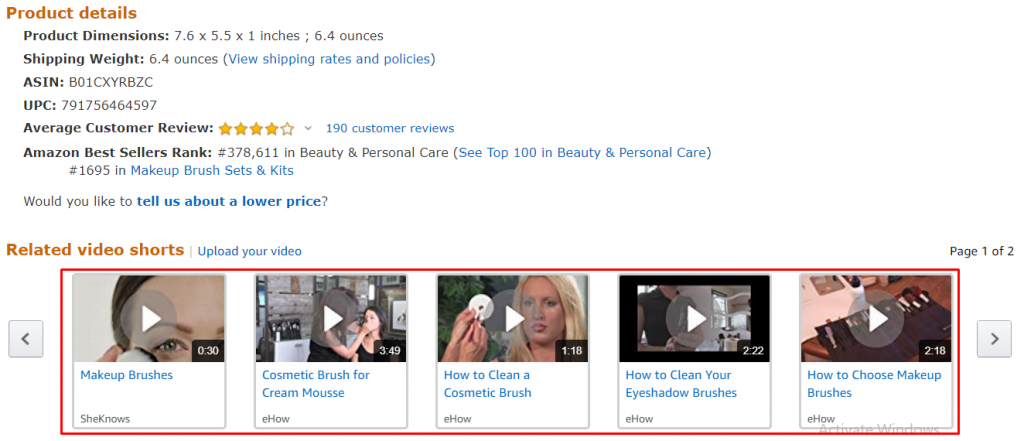
The same video can be used for driving traffic to your online store by publishing it on social platforms and of course, on your eCommerce website.
Pro Tip – The most preferred social platforms (in order) to post video content are
Facebook
Twitter
LinkedIn
Giveaways and Sweepstakes
Customers never shy away from contests, especially when they are assured of a satisfying reward. Contests, in the form of giveaways and sweepstakes, are meant to sell more products, generate leads, and get feedback. Here, the intent of the contest is to drive traffic to your online store.
How to drive customers to your store with a contest?
Use social media as a platform to promote and run a contest so that more people notice it.
Take a look at this sample Facebook giveaway.
“Pick a product that is on flash sale from our website. Share it via your Facebook handle and tag at least 3 friends of yours in the post. Also, add a link back to our website. Simply tag and receive your favorite makeup product as a giveaway.”
In this giveaway contest, the customer will do some window shopping to choose a product. Later on, tagged friends too do the same. This chain simply multiples and the website traffic skyrockets within no time.
Sweepstakes is also similar to a giveaway but with a minor difference. Sweepstakes mostly include monetary benefits and only a select number of people from the lot will win it.
Takeaway – There must be a point of contact with the eCommerce website in the contest where a number of customers tend to spend quality time.
Turn Loyal Customers into Advocates
The stock market churns out money when the investor is asleep. Only the primary investment taking into account transaction opinions.
The game of advocacy rather termed ‘advocacy marketing’ is synonymous with this scenario. Loyal customers boost eCommerce growth whole-heartedly by promoting a brand with just partial involvement from the team behind it. This is absolutely the answer to the question ‘how to drive traffic to your online store free?’. But does this happen without expecting anything in return? Not at all times.

How to encourage advocacy?
The company must
- Initiate a campaign/contest
- Ask for referrals
- Give rewards
All of these were discussed earlier. To sum up, advocacy marketing is an aspect that unfolds after a contest is announced or when people are referred.
Stats that prove the worth of advocacy marketing
- Advocacy increases marketing effectiveness by 54%.
- 92% of people trust word-of-mouth recommendations.
- 76% of individuals count on posts shared by first-hand consumers rather than from brands.
Benefits of advocacy marketing
- Less effort from the side of the company
- Highly cost-effective
- Identify loyal user base
- Get more customers
Increase customer retention by sending highly customized emails that engage customers with Retainful.
Final Thoughts
Now for the real truth. The tactics that you have gone through here will not work out for all WooCommerce and Shopify stores because the make of each store is different.
To increase eCommerce traffic, use a reliable website traffic analysis tool to identify flaws and gather insights from your customers about their interests. Use that data to improve your online store performance.
Times are changing. ‘Cater to your customers and then for the search engines, says Neil Patel. He can’t be wrong because he leads by example.

